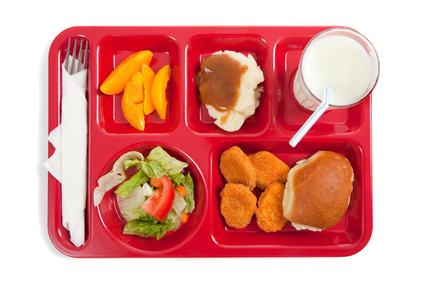 The 2010 federal school nutrition standards have helped educate many of our students about new and healthy foods. A recent study by the Harvard School of Public Health showed that the new school meal standards have not lead to an increase in food waste; however, plate waste has long been an issue in schools that needs to be addressed.1
The 2010 federal school nutrition standards have helped educate many of our students about new and healthy foods. A recent study by the Harvard School of Public Health showed that the new school meal standards have not lead to an increase in food waste; however, plate waste has long been an issue in schools that needs to be addressed.1
Parents can certainly play a role in curbing food waste at school. They can try a variety of strategies at home to help their children open up to foods that may be unfamiliar. Learn more about these strategies here. Since it takes a couple of tries for children to accept new foods, something as simple as serving some of the new foods offered at school can go a long way in making children much more comfortable with opening up their food palette at school.
School, state, and federal policy makers are working to help to curb food waste at schools. With short lunch periods and increased fruits and vegetables options offered with meals, many of our students do not have adequate time to enjoy and finish their meal. The USDA has given schools support to help tackle food waste inside the cafeteria. The USDA recommends that all schools provide students with at least 20 minutes to eat after being served. To reduce the amount of food ending up in trash cans, the USDA also allows schools to let students take certain breakfast or lunch items to eat at a later time after the breakfast or lunch serving period. Learn more about USDA guidance in encouraging schools to allow students to share or save uneaten food items here: Memo SP 41-2014
Currently, there is no federal prohibition against a student saving an apple to eat afterschool if she did not bite into it during lunch. In fact, this is a much better option than her purchasing a sugary snack at the convenience store across campus afterschool. This USDA policy (sometimes called the “travelling apple”) applies to food items that are not temperature sensitive, such as whole fruit, pre-packaged vegetables and fruits, bread and shelf-stable items. Food service professionals can revisit the school district’s policy with school administrators and the health department if the school does not allow food to leave the cafeteria. School districts in California have already taken advantage of this option. California Food Policy Advocates recently published a fact sheet that highlights some creative strategies that school districts have adopted (e.g., shared tables, “backpack-safe” labelling, and food donation programs) to help curb food waste and ensure students are getting the benefits of a nutritious school meal. Read more about California’s best practices. CFPA Fact Sheet: Feeding Students, Not Trash Cans
Discarded food is a lost opportunity for improving student nutrition and a waste of precious resources. We want healthy students, not full trash cans. Ensuring students have adequate time to eat and appealing menu options greatly reduces the potential of excess plate waste. Whether you are a parent, school official or health program leader, give these strategies a try and you might help create happier students and leaner trash cans.
Contributor
Ariana Oliva, California Food Policy Advocates
Source
1 Cohen JFW, Richardson S, Parker E, Catalano PJ, Rimm EB. Impact of the New USDA School Meal Standards on Food Selection, Consumption, and Waste. Am J Prev Med 2014;46(4):388–94.
